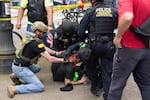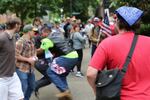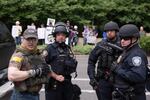
Todd Kelsay, left, assisted federal law enforcement officers in restraining and handcuffing an antifa protester outside of a pro-Trump free speech rally in Portland on Sunday, June 4, 2017. Kelsay's involvement in the arrest has sparked an investigation by the U.S. Attorney's Office.
Bryan M. Vance / OPB
The U.S. Attorney’s Office is investigating an arrest conducted by federal law enforcement officers at a pro-Trump free speech rally in Portland.
The investigation was initiated in part by photos OPB documented that show two private citizens assisting officers in detaining and arresting a counter-protester.
One of those people — identified as Vancouver, Washington, resident Tusitala "Tiny" Toese — grabbed the protester and threw him to the ground. According to Willamette Week, Toese has physically assaulted protesters before.
A second person, identified as Todd Kelsay, then assisted three Federal Protective Service officers in restraining and handcuffing the protester. Kelsay is an Army veteran, who said he has "law enforcement training through corrections." He's also a member of a III Percent militia-style group.
Those photos of Kelsay and Toese have sparked criticism from left-wing groups, who say local and federal law enforcement should have stopped the two men from participating in the arrest.

In 2017, Tusitala “Tiny” Toese, center, a known member of the militia style group, the Oath Keepers, was photographed tackling an Antifa protester before federal law enforcement officers detained the protester and arrested him.
Bryan M. Vance / OPB
Lucy Martinez, a spokesperson for the Department of Homeland Security, told OPB in an email that the FPS officers were "operating within the scope of their authority" when they carried out the citizen-assisted arrest.
While the officers appear to have acted within the law, law enforcement agencies on hand Sunday had agreed before the rally to limit the involvement of self-described "private security," who said they were invited by Republican Party members.
"My understanding is that event organizers were asked to make sure that private 'security' would not interfere in any arrest scenario,” Portland Police Bureau spokesperson Sgt. Pete Simpson told OPB in an email.
FPS corroborated Simpson's statement in an interview Thursday.

Private citizens acting as crowd control for the pro-Trump rally at Terry Schrunk Plaza Sunday, June 4, 2017, identified themselves via yellow stripes on their shoulders and backs. Law enforcement agencies have come under fire for collaborating with these citizens, some of whom are known-members of militia style groups such as the Oath Keepers and Three Percenters.
Bryan M. Vance / OPB
"There was a number of agreements put into place between all of the [law enforcement agencies] — the Multnomah [County] Sheriff’s Department, the state police, FPS and the Portland Police Bureau — to make sure that we were all operating on the same sheet of paper, so that we were all kind of running our operations the same way,” FPS Director of Communications Robert Sperling said.
OPB's Bryan M. Vance spoke with Kelsay — a member of a self-described patriot group — about his involvement in the arrest and his role at the rally Sunday.
Q&A with Todd Kelsay
This interview has been edited and condensed for clarity.
Bryan M. Vance: Can you tell me who you were representing at the rally Sunday?
Todd Kelsay: I was there representing the American public. I am affiliated with some patriot groups, which I will not name. I am a patriot, I believe in our Constitution.
The purpose of me going there was to assist with crowd control. I guess the best way I could describe myself is — well, I went there to promote safety at a rally. Personal safety for people involved. I don’t want anybody to get hurt.
I went there to try to keep people safe that were expressing their First Amendment rights.
Vance: You were working to help secure everything?
Kelsay: Well, don't say secure, OK. I was there as crowd control. My view of why I was there is: I want to assist the police officers in keeping a clear buffer between — I'm saying Side A and Side B. You can pick whatever side you want.
What I did, what my goal there to do was to create a buffer space so the police officers and federal agents could do their jobs safely. And my goal also was to try to protect the safety of individuals within the rally.
The police officers had set up yellow tape. I was inside that yellow tape. I was following directions of police officers all day long. They would ask me to clear off the sidewalk and give them a larger buffer, so that’s what I would do.
Vance: They actually requested for you to do that?
Kelsay: Yes. They also had requested that if we saw any weapons or if we saw somebody that looked like they were going to create violence to let them know and that they would remove them from the site.
I was not contracted by the police to do anything. I was there as voluntary assistance.
Vance: Were you there as private security for the rally organizers?
Kelsay: For crowd control. Not for security. My personal view is I don't want any animosity between the sides. I would love everybody to find common ground and work from that common ground toward common goals, instead of throwing rocks at each other and cursing at each other.
I make it a point to try to stay very neutral.
(Editor's note: Kelsay's social media show he supports President Trump, and frequently criticizes liberal groups, including antifa protesters in Portland.)
We asked several Trump rally-goers to leave because they were too aggressive. In fact, I probably asked more rally-goers to leave than I asked protesters to leave.
Vance: So if you were there for crowd control, why did you help officers arrest someone?
The police had cordoned off areas and said, "Protesters over here. Rally-goers over here. Please keep it that way, that way we don’t have any physical altercations."
Well, you know, the protester came within the limits of what the police officers had set as a basic no-go area for the protesters. And he was wearing a mask.
I approached him, asked him to take his mask off. Asked him if he was a protester ... I don’t remember my exact wording. At that point in time, the police officers had already told us that they wanted that sidewalk clear.
My main job that entire day was keeping the rally members back, and I was telling everybody, "Stay within the bricks."
We had reports from the police officers that the antifa members were using slingshots and trying to shoot people with slingshots. And I didn’t want anybody to get hurt. So I was trying to do exactly what the police officers asked me to do, and it didn’t make any difference if it was an antifa member or if it was one of the rally members.
In fact, one of the speakers of the rally came out on the sidewalk and I turned him around and I said, "You know what, you need to go back within the bricks because the police officers have asked us to keep everybody back within the bricks."
Vance: So you were just following the directions of the Department of Homeland Security officers there?
Kelsay: Yes, sir. I was there as a private citizen. I didn't have to do that. But I feel obligated to do that because I want to promote safety at these things and I want Side A to start listening to Side B, and Side B to start listening to Side A.
Vance: If law enforcement officers were there, why did you get involved? What do you remember?
Kelsay: Within the videos you see several police officers come within the police tape. I think what they were trying to do was maybe allow us to get him to leave on his own accord. I don't know. I don't know what their thinking was and I didn't ask. But there were several police officers who came within the yellow tape within the rally area at that time. In fact, it was those same officers that arrested him.
Vance: The same ones that told the protester to leave the area?
Kelsay: I don't know that they actually told him to leave. I don't know. I know that we had alerted them to his presence.
Then he started walking away. I was following him while he was walking away because, once again, that’s the situation where someone gets punched in the back of the head. That’s the situation where a fight breaks out. So I’m not necessarily following a single guy. What I’m doing is I’m following a potential problem.
Then, one of our other crowd control guys approaches him, because he had been watching me talk to the guy and he had been watching the guy refuse to take his mask off.
Anyway, so the guy walks away from me and I follow him. Then the other gentleman talks to him, and then at that point the police were walking up behind [the protester] at that point as well.
He takes off running, I’m hearing the police yell at him, "Stop. Stop. Stop him. Stop him."
Vance: And that's when you got involved?
Kelsay: I'm following so that if I need to lend a hand I can do so. I didn't tackle the guy. I helped the police officers roll him over. And to be quite honest, I helped the police officers roll him over because I didn't want him to get hurt, I didn't want any of the police officers to get hurt, and I didn't want anyone else to get hurt.
I think you can see in the video that I was not being very aggressive at all.
At the point that he got rolled over on his stomach, the police officer, the federal agent, looks in my direction — and I’m sitting 4 inches from him — and he says, "Can you get the flex cuffs off my back?"
And I said, "Yes sir." So I got a set of flex cuffs off his back and I handed it to him.
As he slipped them on, he said, "Can you tighten that up a little bit?"
And I said, "OK." I tightened them up a little bit.
At that point, I let go of the flex cuffs and (the protester) because I don’t know how tight they need to be. I know it can cause damage if you get them too tight. I know for a fact that there was still a large gap around the guy’s wrist, that his hand could have come out of at the point that I stopped tightening. The police officer did the final tightening and the final fit of the cuffs.
Then they rolled him over and I helped them stand him up because I was handy. And once again, the more hands that are on a person, the less it hurts.
And then, I was done. I turned around and walked off.
Vance: Did you communicate with the arresting officers after the arrest?
Kelsay: I think a few of them said, "Thank you for the hand." I really don't know. To me the whole incident seems like it took about two seconds, do you know what I mean?
There’s nothing against the law about a civilian helping a police officer. Especially when they ask for help.
Vance: And you remember the officer specifically asking you for help?
Kelsay: Yes, and you can see in the video. He turns and looks at me. After he turns his head to the right, then you can see me lift up and start to try to get the flex cuffs off his back. They were actually quite difficult to get off because there were so many cuffs on there that it was hard to the get carabiner open to get the flex cuffs off.
Vance: So you would say you weren't targeting anyone?
Kelsay: No. I was there purposely for the safety of all individuals involved. I didn't want anybody to get in a fight. There were people on both sides of the fence, and you saw it. You were within the [area].
There were a bunch of rally-goers that all they want to do is show up to these events and fight. I totally disagree with that. That is not how anything gets solved. How things do get solved is through calm speech. And once again, I don’t fully agree with the tactics of or the message of either side.
Related: Portland 82nd Avenue Rose Parade Canceled Over Counterprotest Threat
Vance: How did you get involved with the rally Sunday? Did you reach out to the organizers or did the organizers reach out to you?
Kelsay: As I said earlier, I'm a member of more than one patriot group. I will say that none of the patriot groups that I'm involved in were directly involved in the rally Sunday, officially.
I’m a constitutionalist. I’m not an alt-right, and to be quite honest I’m not sure what the definition of alt-right is. It’s not good, in my opinion. I’m not an extremist. I’m an American citizen. I love God. I love my family. I love my country, and I love the Constitution.
So, I just want to try to protect everyone’s First Amendment rights, whether I agree with you or whether I don’t agree with you.
Antifa has every bit as much right to peacefully protest as I do. But where I draw the line is when people go through and they burn police cars. When they go walk through the street and bust out windows of businesses. That’s not protected under the First Amendment.
If everyone would sit together and talk and find their common ground, then I think these issues would go away. I really think that we could find a solution.
Vance: Has anyone from law enforcement reached out to you since Sunday?
Kelsay: Not to my knowledge.
